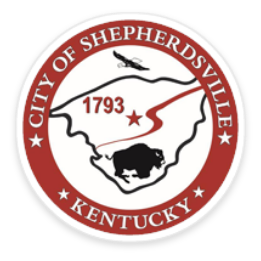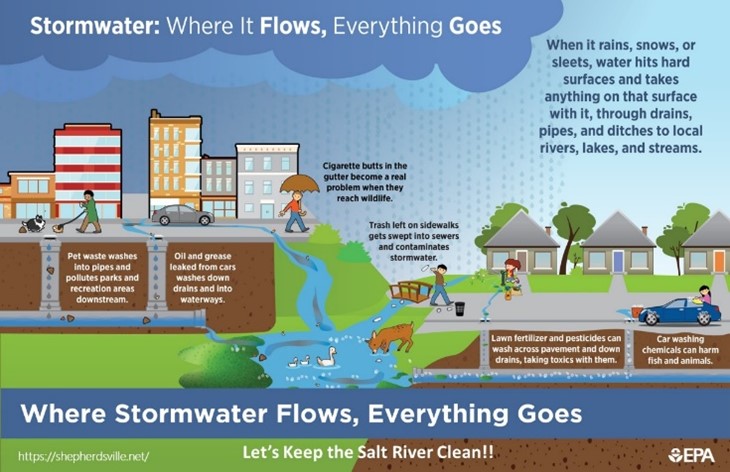Stormwater MS4
A Municipal Separate Storm Sewer System (MS4) is a stormwater conveyance system that is owned by a public entity (city, town, county.). The size of the public entity determines whether the MS4 is designated as a Phase I or Phase II MS4. The Bullitt County Fiscal Court, the City of Shepherdsville, and Five Northern Cities are co-owners or co-permittees of a Phase II MS4.
Components of the MS4
The City of Shepherdsville’s stormwater conveyance system, which includes stormwater pipes, culverts, and ditches, plays a vital role in managing runoff within the region. These components are designed to channel stormwater into the waters of the U.S., with the Salt River being the primary recipient of the stormwater discharged by the Bullitt County Fiscal Court/City of Shepherdsville MS4.
It is crucial to note that the MS4’s conveyance system is entirely separate from the sanitary sewage system and is solely dedicated to handling stormwater runoff. This segregation ensures that stormwater and sewage do not mix, preventing potential environmental contamination.
The operation of the MS4 is carried out under a permit, which undergoes renewal and reissuance every 5 years. Issued and regulated by the Kentucky Division of Water, this permit is known as the Bullitt County Fiscal Court/Shepherdsville’s MS4 Phase II permit. To adhere to the Kentucky Division of Water regulations, the Bullitt County Fiscal Court and co-permittees are obligated to implement measures that enhance the water quality of all stormwater discharged into the U.S. waters.
The MS4 is designed with 6 minimum control measures (MCMs), each with specific guidelines and objectives to ensure effective stormwater management and improve water quality. These measures play a crucial role in safeguarding the environment and mitigating the potential impacts of stormwater runoff on the local water bodies and surrounding ecosystems.
Public Education and Outreach
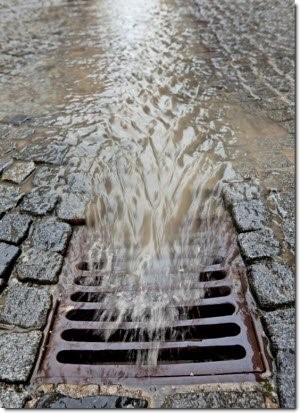 In developed areas, stormwater in the form of rain or snow flows over streets, parking lots, and roofs collecting excess nutrients and pollutants before entering a storm drain, ditch, or water body. In undeveloped areas, precipitation typically soaks into the ground. In developed areas, there is no opportunity for soil and plants or a water treatment facility to filter out pollutants. Developed areas also produce much more stormwater runoff due to the high amount of paved and hard surfaces.
In developed areas, stormwater in the form of rain or snow flows over streets, parking lots, and roofs collecting excess nutrients and pollutants before entering a storm drain, ditch, or water body. In undeveloped areas, precipitation typically soaks into the ground. In developed areas, there is no opportunity for soil and plants or a water treatment facility to filter out pollutants. Developed areas also produce much more stormwater runoff due to the high amount of paved and hard surfaces.
Stormwater runoff is often exacerbated by human activities and can contain nitrogen and phosphorus pollutants from fertilizers and yard waste.
E. coli is a bacterium that normally lives in the intestines of people and animals. Certain types can cause an intestinal infection. It can lead to severe, potentially life-threatening complications. E. coli from animals can enter waterbodies in stormwater runoff from pets, feedlots, manure storage areas, or areas where there is wildlife. Livestock that are allowed to get into or near streams can introduce E. coli directly into surface water.
Public Involvement/Participation
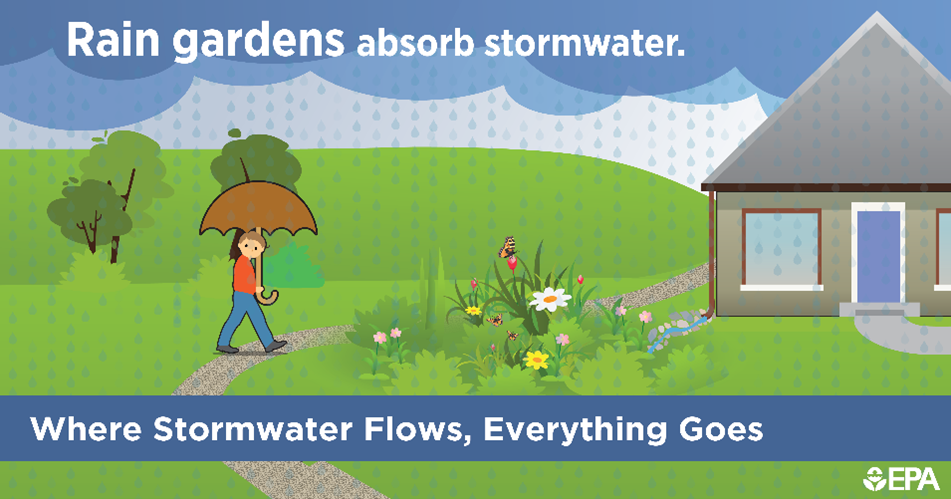 What you can do at your home
What you can do at your home
- Clean up your pet’s waste before it gets washed away by stormwater runoff.
- Wash your Car, Truck or Boat with biodegradable soap.
- Do not overspray lawn chemicals or fertilizer on your driveway.
- Construct a green infrastructure project at your home. Examples of green infrastructure techniques that can be implemented at home include rain gardens, pervious pavement, rain barrels, and green roofs.
Green infrastructure can be used to address stormwater runoff and sewer overflow problems. Green infrastructure can be applied at home and in the community. Green infrastructure works by slowing down the runoff, spreading it out over the land, and slowly soaking it into the ground, or in certain cases reusing the water onsite. Green infrastructure techniques also help to remove pollutants from runoff, by allowing plants to filter out pollutants as the water slowly infiltrates into the ground.
You can learn more about green infrastructure by contacting your City Engineer’s Office.
What you can do as a member of your community
We are committed to cleaning up our stormwater discharge. You are both invited and encouraged to help us improve the quality of our waterways.
Look for upcoming invitations to join in on exciting and rewarding community stormwater projects.
Stormwater Management Questionnaire
The City of Shepherdsville operates its Stormwater Program in compliance with the City’s Municipal Separate Storm Sewer System (MS4) Permit. This permit is mandated by the Kentucky Division of Water, in an effort to improve the quality of water discharged through a municipality’s separate storm sewer system.
As required by the MS4 Permit, the City of Shepherdsville seeks public comment on the Stormwater Program. Please complete this questionnaire and identify any concerns you may have regarding the City of Shepherdsville’s Stormwater Program.
When completed with questionnaire return by:
Mail or Dropoff at: City of Shepherdsville, 634 Conestoga Pkwy, Shepherdsville, KY 40165
Email: jgosser@shepherdsvilleky.gov or scummings@shepherdsvilleky.gov
Illicit Discharge Detection and Elimination
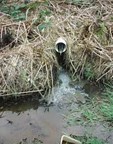
Only rainwater should be discharged into our streams and waterways. If it is not rainwater and it is being discharged into our stormwater collection system or directly into our waterway’s (streams, creeks, rivers, lakes.) then it is an illicit discharge.
Examples of illicit discharges include:
- Effluent from septic tanks
- Untreated waste from industrial facilities
- Concrete Washout from construction sites
- Untreated sanitary sewer water from a residence or business.
Illicit discharges are illegal and punishable by fines up to $1,000 dollars per day. If you encounter an illicit discharge, we encourage you to report them through the illicit discharge form or by calling Scott Flemming at 502-664-6254.
Construction Site Runoff Control
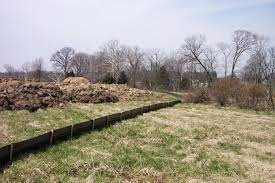 Construction sites typically generate a lot of potential stormwater pollutants. These pollutants include silt and sediment from disturbed areas, oil and petroleum products from machinery and concrete and bituminous asphalt wastes from paving and building operations. All construction projects that involve site disturbance activities are required to implement measures that will capture these potential pollutants before they can contaminate stormwater runoff from the construction site.
Construction sites typically generate a lot of potential stormwater pollutants. These pollutants include silt and sediment from disturbed areas, oil and petroleum products from machinery and concrete and bituminous asphalt wastes from paving and building operations. All construction projects that involve site disturbance activities are required to implement measures that will capture these potential pollutants before they can contaminate stormwater runoff from the construction site.
Pollutants are captured or contained by implementing Best Management Practices (BMPs). These BMPs include but are not limited to silt fencing, temporary construction entrances, inlet and headwall protection.
 The Environmental Protection Agency (EPA) has developed guidance for the construction of BMPs.
The Environmental Protection Agency (EPA) has developed guidance for the construction of BMPs.
All proposed construction must be reviewed and pre-approved before any site disturbing construction activities begin. Begin the construction approval process.
Post-Construction Management for Development
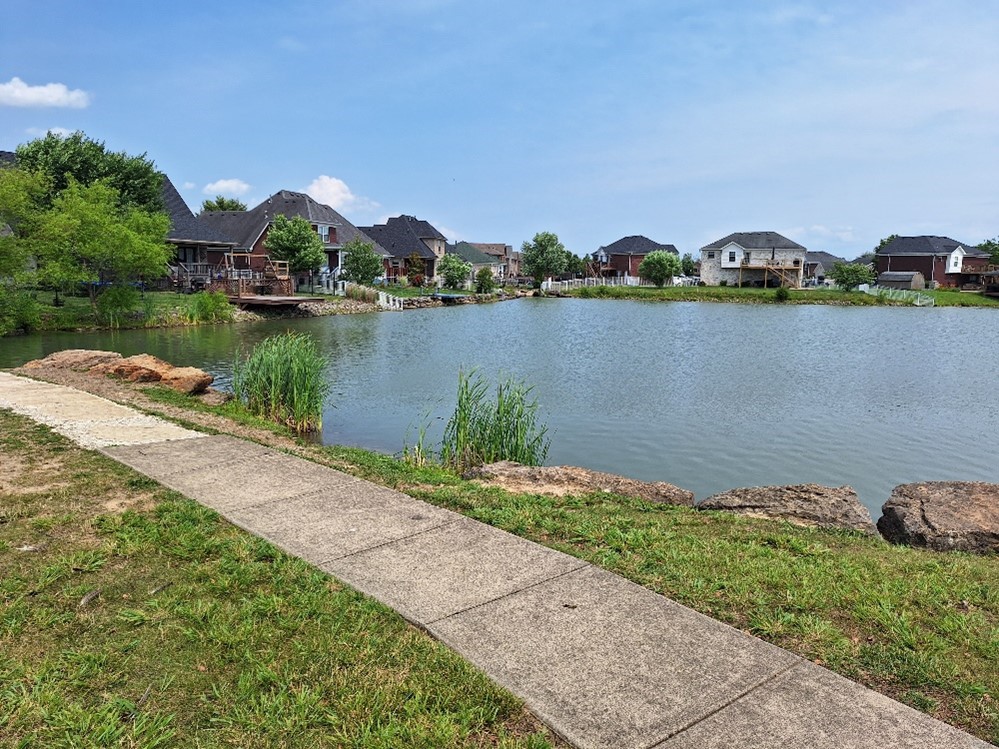 Development affects both stormwater quality and quantity. New development in an area typically increases both the number of pollutants and the amount of stormwater runoff produced by the development site. New development usually means more impervious surfaces. These impervious surfaces, roofs, parking lots and roads for example, all contribute to increased pollution and increased stormwater runoff quantities.
Development affects both stormwater quality and quantity. New development in an area typically increases both the number of pollutants and the amount of stormwater runoff produced by the development site. New development usually means more impervious surfaces. These impervious surfaces, roofs, parking lots and roads for example, all contribute to increased pollution and increased stormwater runoff quantities.
The best way to address both the stormwater quality and quantity problems associated with development is with the use of BMPs. These BMPS can reduce both the number of pollutants and the rate that stormwater leaves a developed site. These BMPs are addressed and become a required component of any development plan. BMPs that target pollution control while also addressing stormwater runoff rates are known as green infrastructure.
The City of Shepherdsville is currently planning to implement the following green infrastructure.
Pollution Prevention/Good Housekeeping
Pollution Prevention/Good Housekeeping for Municipal Operations.
It is far less expensive to prevent pollutants from entering a waterway than it is to clean up and restore the waterway once it has become polluted. Pollution prevention is a function or result of good Housekeeping. Examples of good housekeeping include:
- Regular inspection and maintenance of installed BMPs.
- Constructing BMPs at pollutant generating locations such as city garages, waste transfer stations and road salt storage areas.
- Incorporating water quality controls, green infrastructure, into flood control projects.
- Training municipal staff involved with activities that could be associated with the discharge of pollutants into our waterways.
The Shepherdsville Engineering Department is working diligently to improve the water quality of all stormwater discharged by the community. You may check out our current Stormwater Quality Management Plan (SWQMP).
Planning to Build a Residence, Residential or Commercial Development?
Any construction project that includes land disturbing activities must be approved by the MS4 Engineering Staff before construction may begin. Please review the Site Plan Checklist and Plan Submittal Application
